
The Cyperaceae are a family of graminoid (grass-like), monocotyledonous flowering plants known as sedges. The family is large; botanists have described some 5,500 known species in about 90 genera – the largest being the "true sedges", with over 2,000 species.

Eriophorum angustifolium, commonly known as common cottongrass or common cottonsedge, is a species of flowering plant in the sedge family, Cyperaceae. Native to North America, North Asia, and Europe, it grows on peat or acidic soils, in open wetland, heath or moorland. It begins to flower in April or May and, after fertilisation in early summer, the small, unremarkable brown and green flowers develop distinctive white bristle-like seed-heads that resemble tufts of cotton; combined with its ecological suitability to bog, these characteristics give rise to the plant's alternative name, bog cotton.

Eriophorum is a genus of flowering plants in the family Cyperaceae, the sedge family. They are found in the cool temperate, alpine, and Arctic regions of the Northern Hemisphere, primarily in the middle latitudes of North America, Europe, and Asia.
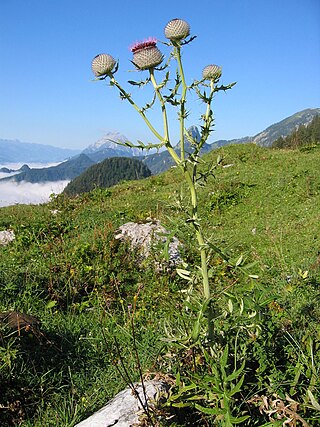
Cirsium eriophorum, the woolly thistle, is a herbaceous biennial species of flowering plant in the genus Cirsium of the family Asteraceae. It is widespread across much of Europe. It is a large biennial plant with sharp spines on the tips of the leaves, and long, woolly hairs on much of the foliage. The flower heads are large and nearly spherical, with spines on the outside and many purple disc florets but no ray florets.
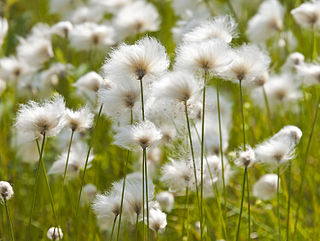
Eriophorum callitrix, commonly known as Arctic cotton, Arctic cottongrass, suputi, or pualunnguat in Inuktitut, is a perennial Arctic plant in the sedge family, Cyperaceae. It is one of the most widespread flowering plants in the northern hemisphere and tundra regions. Upon every stem grows a single round, white and wooly fruit. The seeds are covered in this cottony mass and usually disperse when the wind carries them away. Eriophorum callitrix has narrow, grass-like leaves. Its habitats include tundra and calcareous bogs.
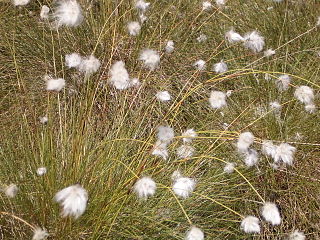
Eriophorum vaginatum, the hare's-tail cottongrass, tussock cottongrass, or sheathed cottonsedge, is a species of perennial herbaceous flowering plant in the sedge family Cyperaceae. It is native to bogs and other acidic wetlands throughout the Holarctic Kingdom. It is a 30–60 cm high tussock-forming plant with solitary spikes.

Carex bigelowii is a species of sedge known by the common names Bigelow's sedge, Gwanmo sedge, and stiff sedge. It has an Arctic–alpine distribution in Eurasia and North America, and grows up to 50 centimetres (20 in) tall in a variety of habitats.
Gracility is slenderness, the condition of being gracile, which means slender. It derives from the Latin adjective gracilis, or gracile (neuter), which in either form means slender, and when transferred for example to discourse takes the sense of "without ornament", "simple" or various similar connotations.

Eriophorum viridicarinatum is a species of sedge known by the common names thinleaf cottonsedge, green-keeled cottongrass, and bog cottongrass. It is native to Canada and the United States.

Centaurium pulchellum is a species of flowering plant in the gentian family known by the common name lesser centaury, or slender centaury. It differs from Centaurium erythraea by lacking basal rosette of leaves and by having a developed peduncle below the flowers. It is often much smaller, less than ten centimetres. It is native to the southern temperate parts of Europe.

Eriophorum scheuchzeri is a species of flowering plant in the sedge family known by the common names Scheuchzer's cottongrass and white cottongrass. It has an arctic circumpolar and circumboreal distribution in the Northern Hemisphere. It can be found in Alaska, across Canada, in the Arctic islands, Greenland, Iceland, and across Eurasia. Disjunct occurrences exist in the Rocky Mountains, in the high mountains of southern Europe and on Mount Daisetsu in Japan and some other Asian mountains.

Trichophorum cespitosum, commonly known as deergrass or tufted bulrush, is a species of flowering plant in the sedge family. It was originally described by the Swedish naturalist Carl Linnaeus in 1753 as Scirpus cespitosus, but was transferred to the genus Trichophorum by the Swedish botanist Carl Johan Hartman in 1849, becoming Trichophorum cespitosum.
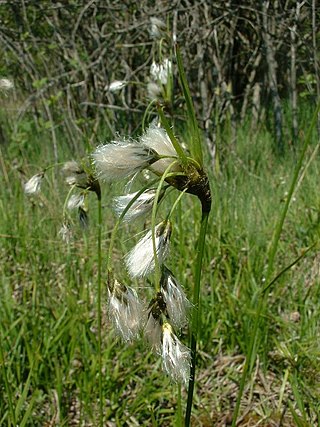
Eriophorum latifolium, commonly known as broad-leaved bog-cotton and broad leaved cotton grass is a species of flowering plant belonging to the family Cyperaceae.
Eriophorum chamissonis is a species of flowering plant belonging to the family Cyperaceae.
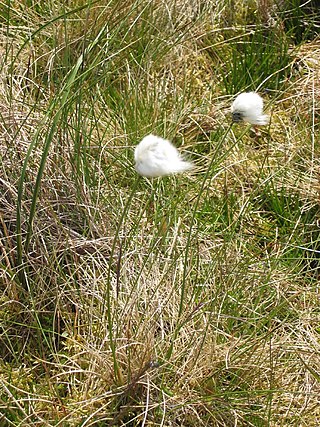
Eriophorum brachyantherum, the closed-sheath cotton-grass, short-anthered cotton-grass or northland cottonsedge, is a species that is a part of the Cyperaceae or sedge family. It is commonly found in wet areas, such as bogs and cooler climate zones.
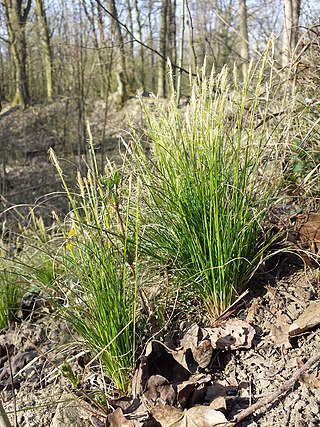
Carex alba, called the small white sedge, white-flowered sedge or just white sedge, is a species of sedge in the family Cyperaceae. It is typically found in temperate forests of Eurasia, from the Pyrenees to the Russian Far East. It is the main host plant for the woodland brown butterfly, Lopinga achine.

Trichophorum cespitosum subsp. germanicum is a subspecies of Trichophorum cespitosum. It is a characteristic plant of nutrient-poor moors, wet heaths and moorland forests in Europe. The mostly hedgehog-shaped form of its tufts is characteristic.

Eriophorum virginicum, the tawny cottongrass, is a species of flowering plant in the sedge family Cyperaceae. It is native to eastern North America but was introduced into both British Columbia and Washington in western North America. It is most common in eastern Canada, New England, and the Great Lakes region. It is the only species of Eriophorum in North America that occurs in the southeastern United States, where it is uncommon. The common name refers to the tawny color of its fruiting head. Despite the name, it is a sedge, not a grass, and it is sometimes called tawny cottonsedge to emphasize this fact.
Eriophorum tenellum is a species of flowering plant in the sedge family Cyperaceae.
















